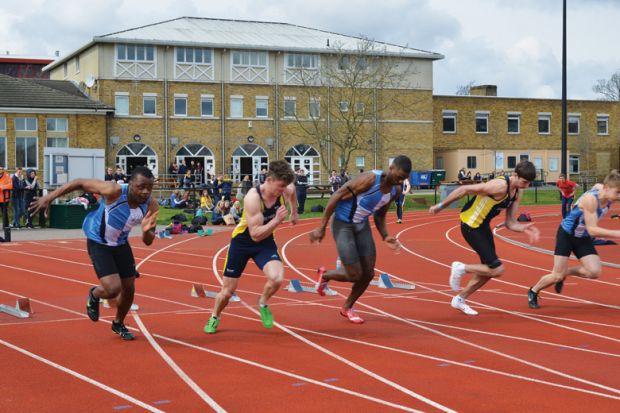Student Experience Survey 2016 results
Sport can often provide students’ fondest memories of university life; the significance going beyond mere nostalgia. Friendships made in the sporting arena, often in defeat, can last a lifetime and teach students more about themselves than a hundred lectures.
“I learned more about leadership by captaining a football team that lost every game, than I ever did by studying theory,” explains Matt Hyde, the former chief executive of the National Union of Students, who now heads the Scout Association.
Those memories of sporting glory and defeat are frequently defined, however, by grim facilities: ramshackle changing rooms with only cold water, football pitches on vertiginous slopes and rugby grounds with barely visible lines came more or less as standard. But this image of student sport is becoming increasingly dated in light of the superb, world-class facilities provided at many UK universities, which have invested heavily in upgrades. Many institutions have opened state-of-the-art sports centres that not only dazzle prospective students on open days, but impress elite athletes too. Most teams in the London 2012 Olympics were delighted with the university facilities that were provided for training.
The top-ranked institution for sport, according to students, is Loughborough University, which takes pole position for the fifth year in succession. Loughborough hosted Team GB four years ago and is home to the England Cricket Board’s National Cricket Performance Centre, a £6 million swimming complex, a world-class gymnastics centre and a 3,500-capacity football stadium.
Other sports venues include a beach volleyball area, a 14-court tennis centre and two campus gyms, with Loughborough topping the British Universities and Colleges Sport inter-university league for an incredible 35 years in a row.
The University of Bath is in second place, with its £30 million Sports Training Village also regarded as one of the UK’s outstanding fitness, coaching and sports science centres. It includes a purpose-built dojo (for judo), a 50m swimming pool, an indoor sprint track and the UK’s only bobsleigh push-start track.
The University of Surrey is in third position, thanks primarily to its £36 million Sports Park opened in 2010, which includes a new £500,000 health and fitness centre.
In joint fourth position are five institutions – the universities of Aberdeen, East Anglia, Northumbria, Stirling, and St Mark and St John, in Plymouth.
Northumbria’s flagship £30 million Sports Central building in Newcastle city centre is the hub of the university’s sporting life, explains deputy vice-chancellor Peter Francis. “It’s a place that students of all levels of ability can use, not just those involved in high-performance sport,” he says, revealing that athletic participation at Northumbria has doubled in recent years, with about 2,000 students taking part in 30 sports each week.
The 3,000-seat indoor stadium (home to the Newcastle Eagles, the UK’s most successful basketball team) means elite athletes are often on campus.
Providing training facilities for elite athletes, competitive sport for students and fitness opportunities for occasional users is a challenge also faced by St Mary’s University, Twickenham, which is joint 13th for sports in the table. It recently hosted the world’s three best rugby sides (New Zealand, Australia and South Africa) during last year’s Rugby World Cup, while St Mary’s alumnus Mo Farah trained at the campus for many years.
“St Mary’s is synonymous with sport at many different levels – elite sport, student sport and sport in the community,” reflects Andrew Reid-Smith, its director of sport. “When international squads are based here, it’s about supporting them, but we want to turn that to our advantage by using these individuals as role models.”
Having top sportsmen and women on campus has helped inspire students to take part in sport and fitness activities, but St Mary’s has also used a different approach to engage less-sporty types. As part of a Sport England programme, absolute beginners have been encouraged to take part in basketball, volleyball and netball, while its disco-inspired Ultraviolet series of fitness events has torn up the rule book on how university sport is delivered.
“It ends up looking almost like a nightclub,” explains Reid-Smith of the dodgeball, spinning and zumba classes, which are staged under glowing ultraviolet lights. “We even invited a DJ to play some music,” he adds, saying that fitness participation rates have increased by 140 per cent in just a year.
Indeed, the “jolly hockey sticks” or “rugger bugger” image of college sportsmen and women does not ring true these days. The University of Warwick’s Pole Dancing Society has almost 300 members, of whom 25 are men, including its president Matthew Bennett. “I was pretty much the only boy when I joined in the first year,” he says.
Warwick has triumphed in the inter-university pole dancing competition in 2014 and 2015 and hosted the event for a second time this month.
“When we had 400 to 500 people in attendance, 180 competitors and nine invited dancers, the university had to realise that this is something that is taken seriously!” Bennett says.
Register to continue
Why register?
- Registration is free and only takes a moment
- Once registered, you can read 3 articles a month
- Sign up for our newsletter
Subscribe
Or subscribe for unlimited access to:
- Unlimited access to news, views, insights & reviews
- Digital editions
- Digital access to THE’s university and college rankings analysis
Already registered or a current subscriber?






